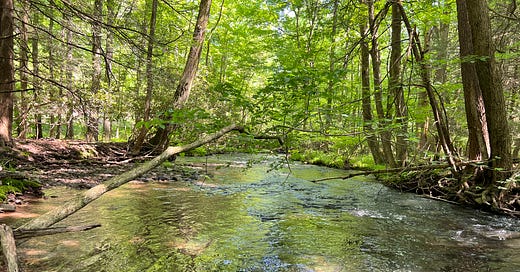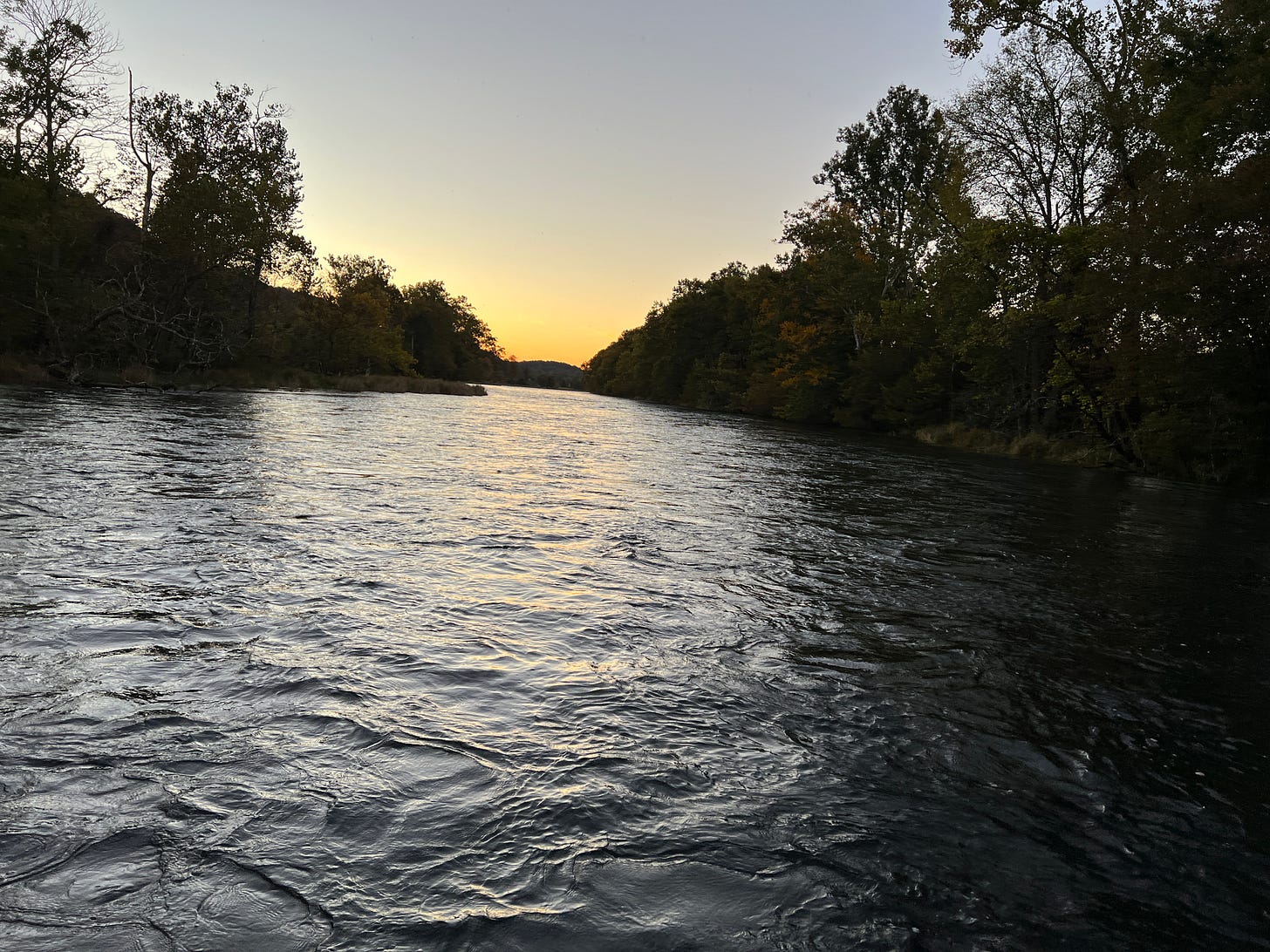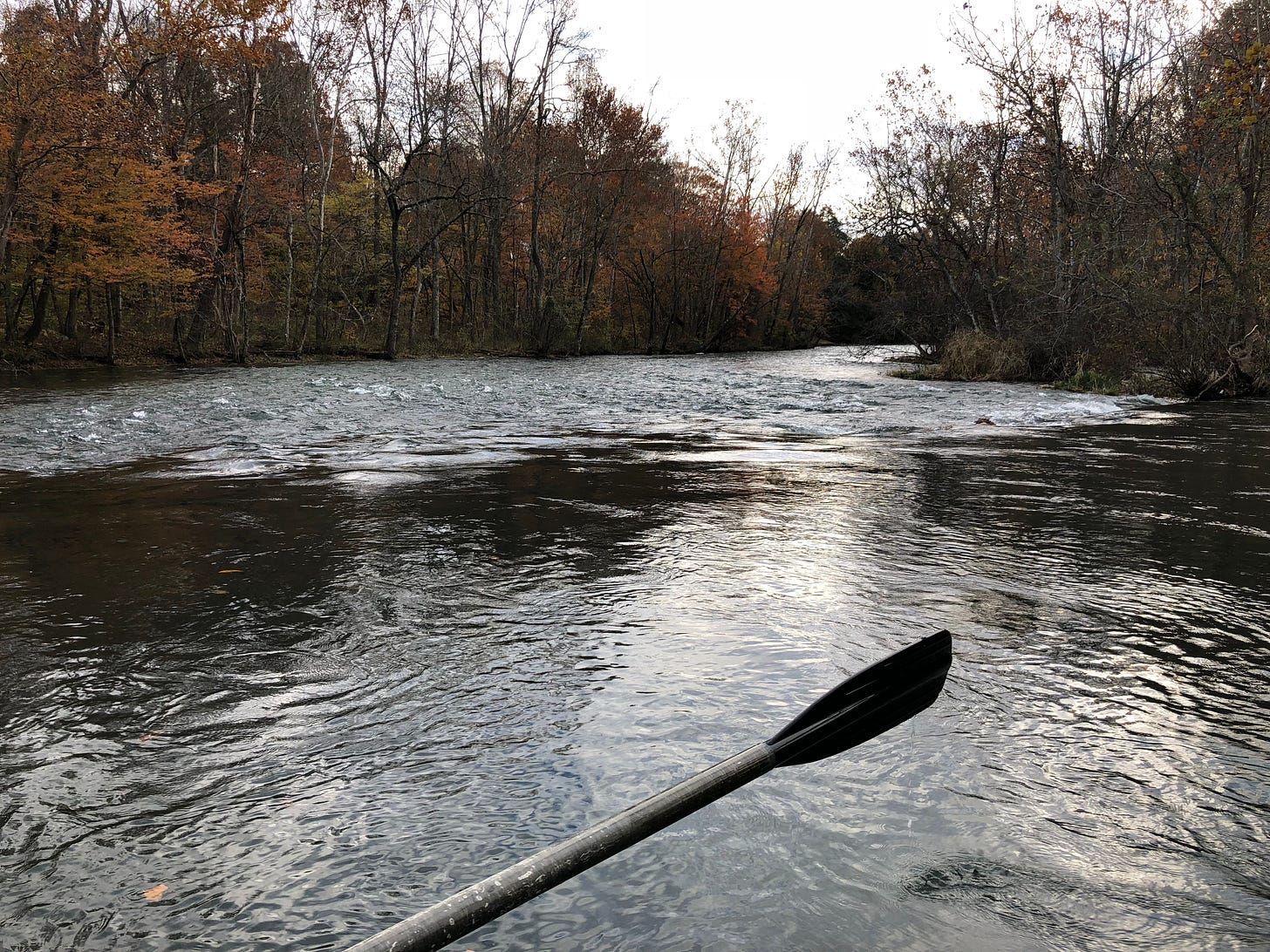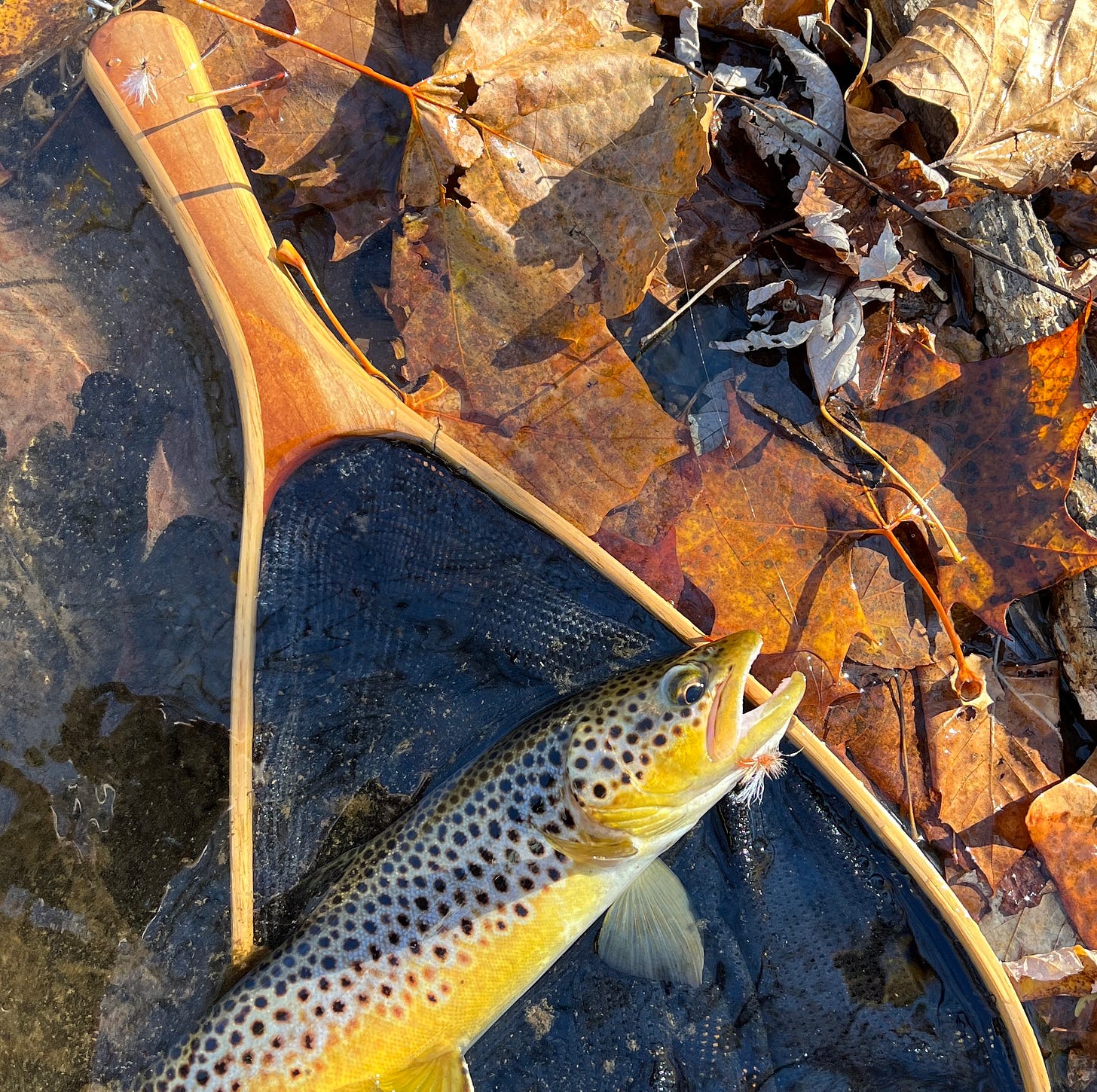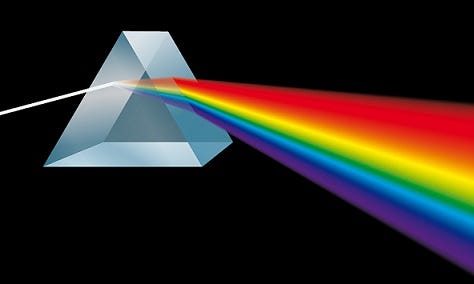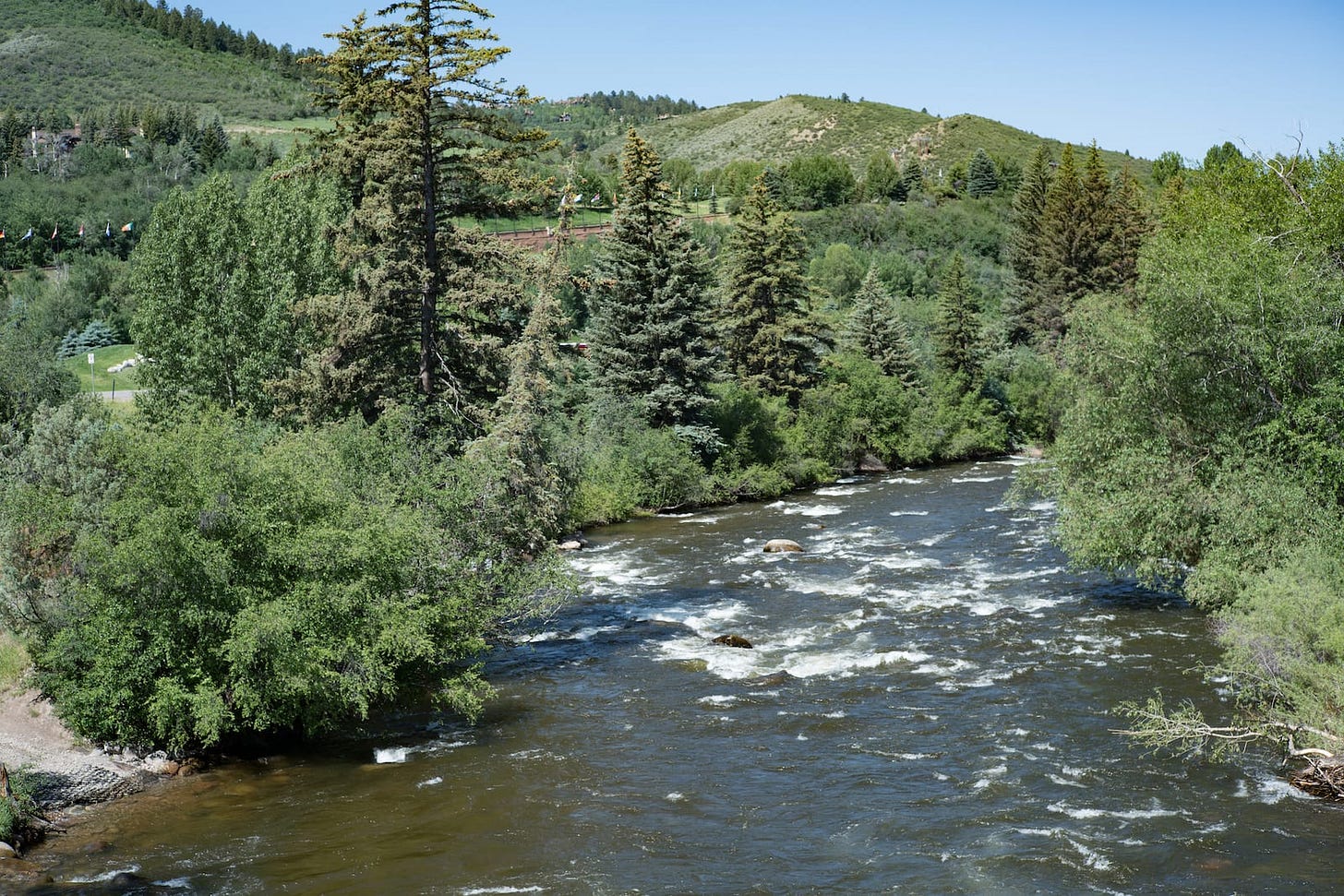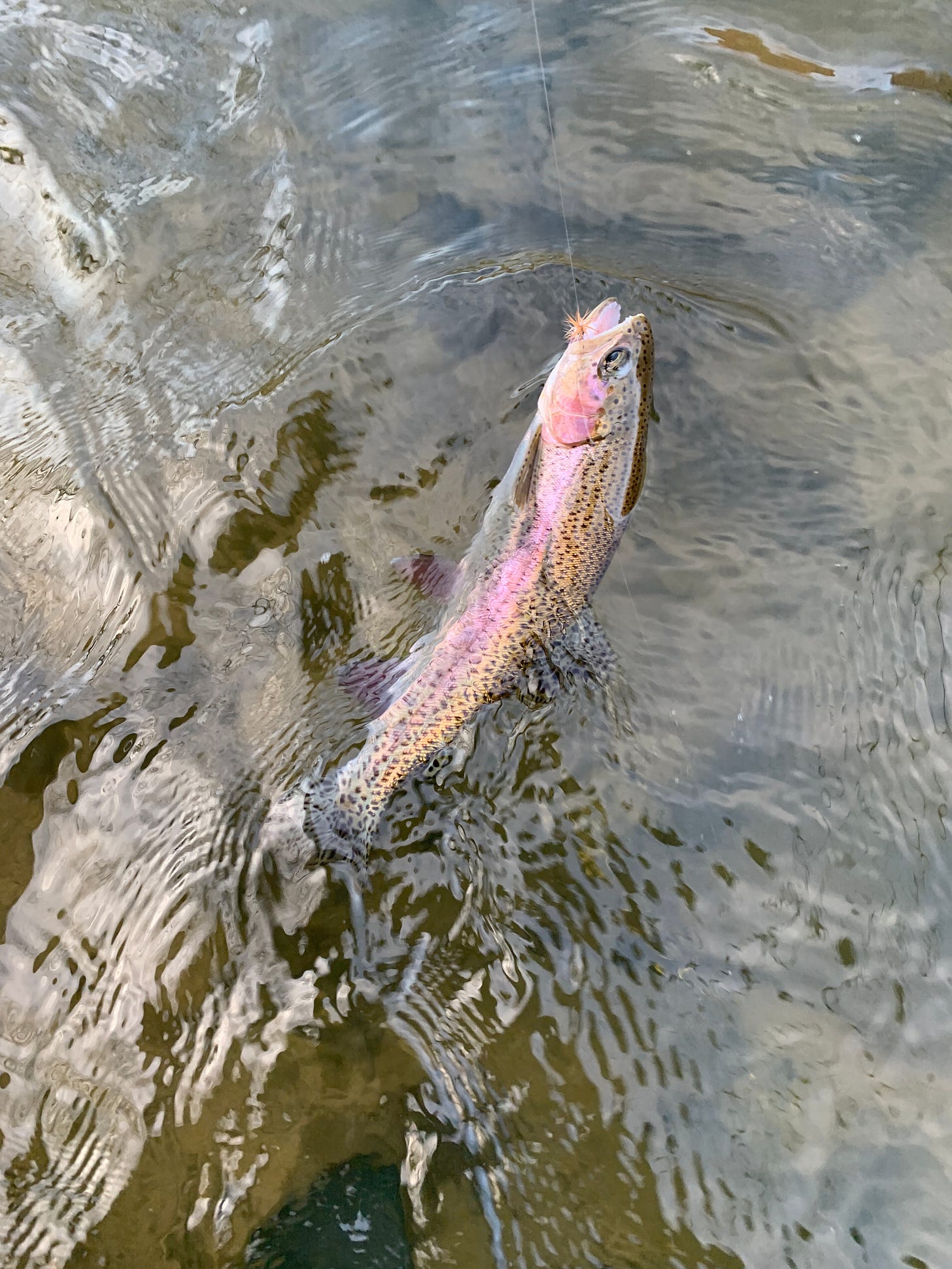Light is composed of segments of various colors. Each color, or shade of light has a different wavelength with the blues being at the shorter end and red being at the longer end of the spectrum. When light hits an object some of it is absorbed by the object and some of it is reflected. There is a complex interaction between materials and different wavelengths of light, but for our purposes the basic fact is that materials absorb certain wavelengths and reflect others. The wavelength of the reflected light is the color we see. So a green object absorbs all wavelengths other than the green which it reflects, and that’s what we see - the green reflected light and we say the object is green. In an environment, any environment, the light reflected from surrounding objects is the dominant light in the area. For example in the picture above the trees are absorbing almost everything other than the green and the whole environment is awash in green light. In the picture below the clouds are reflecting the orange of the sky (which is caused by the light refracting through the sky like light going through a prism) and the whole environment is awash in orange.
We see color based on what an object reflects. So if we had a pure green object (it reflects green light) and we put it in pure orange light it would reflect nothing (it absorbs everything but green so it would absorb the orange light). The absence of all reflected light is seen as black (the reflection of all possible colors shows as white). Of course no natural object or natural light is a pure color so normally we would see mismatched objects in dull mottled colors. Let’s stash that bit of knowledge away for the moment, we’ll come back to it in a bit.
Now let’s look at animal eyes. They’re made of rods and cones. Without going into a lot of detail, we just need to know that rods are more sensitive to low light conditions and contrast (so they tend to see blacks, grays, whites and their shades) while the cones are the ones that work in higher light conditions and provide color vision. But the cones are not equally responsive to all colors. Various researchers have studied the absorption peaks of different types and ages of trout. They generally find two things. The first is that the sensitivity of trout eyes to color changes with age. Young trout generally percieve 4 peaks, one of which is in the UV region. As the trout ages the minimum wavelength the eye responds to increases and the trout tend to lose UV sensitivity. For Brown Trout the peak sensitivities seem to be at 600-630 nanometers (orange - red) 516-535nm (chartreuse to green) & 440 nm (blue).1 There’s a nifty tool at https://academo.org/demos/wavelength-to-colour-relationship/ that can be used to check colors. Just remember that your screen may not show true color but you’ll be in the right ball park.
Some researchers have shown that while the adult trout cones lose their sensitivity to UV light as they mature, there are secondary peaks in the trout cones that may be sensitive to UV.
Now let’s start putting all this together and how it affects fly selection. Let’s first start with color sensitivity. Obviously trout will see colors they are sensitive to best. The colors above should be very familiar to trout and salmon fisherman. These are the colors we find in attractor flies, ones designed to draw fish. Here’s a set of well tested Atlantic Salmon and Steelhead flies. Compare the color palette of these flies to the sensitivity colors.
Another type of fly that often is a pure attractor, or at least has to draw trout from a distance is the traditional wet fly. And you see the same thing show up there. Little flashes of those colors that are on the trout sensitivity peaks. Or the attractor nymphs, such as Frenchies or Hot Spots.
So we see how trout eyes have sensitivity peaks at a set of colors. And through empirical or anecdotal experience fly fishermen have known this for eons. It’s reflected in the colors commonly chosen in attractor fly patterns, whether fishing for anadromous fish or landlocked trout.
But there is one more step to being successful in fly color selection. And that has to do with the reflected light situation we talked about at the top of this post. Obviously if we were to take a fly with an orange highlight and use it in a predominantly green setting it would be less visible than an orange one, and vice versa. So being able to understand what light conditions are present is important. And it may not always be obvious unless you’re looking for it. The green and orange light conditions shown above were obvious. But less obvious was this condition below. I actually took this picture to show my guide why a yellow fly was knocking the fish for a loop.
In the conditions below it’s easy to see why an orange fly would work
But in the fall, after the trees have lost their leaves the hillsides are often shades of orange. At certain times the light reflecting off the hillsides is orange and when that happens the trout will readily take an orange fly.
The late great Gary LaFontaine had a fly pattern he tied in a whole range of colors purely to address different light situations. This was, or is, the Double Wing. A fly I consider to be par excellence as far as dry flies are concerned. Choose the right color and this thing will drag fish up from all kinds of depths.
The green, yellow and orange ones shown below are relatively easy to match to the predominant colors. The orange can often be a killer on western rivers (like my 2nd home rivers in Colorado) where the hills are orange sandstone.
Some of the others may be a little less obvious. For instance when would one fish a gray fly. Well here you go.
LaFontaine talks about fishing a Royal Double Wing on bright days. I have variant I call the Phil (named after another legend, Phil Lesh) that actually works great on slightly overcast days when the predominant light coming through is at the shorter end of the spectrum (i.e. the blues and purples). It replaces the green tail and red tag of the Royal with a purple tail and a kingfisher blue tag.
I hold the duble wing in such high esteem that I tie and carry them by the bucket load. This is about 1/3 of the Double Wings normally in my boat bag.
Let’s now take a bit of time to talk about UV. The fish biologists will tell you that an adult trout has outgrown its UV sensitivity, with the UV cones migrating towards the blue. There are also some who will tell you that there is this secondary peak (called the beta-peak) in the trout eye sensitivity curves that lies in the UV region. But for whatever reason, trout do seem to like flies tied with UV materials under certain conditions. UV light is dominant under a few conditions. On cloudy days, UV being the shortest wavelength penetrates the clouds most and is a predominant component of the light on those days. Also, in the evenings, after the sun goes below the horizon the available light is what refracts around the topography. The shorter wavelengths refract more.
The blues, violets and eventually ultraviolets will dominate as the sun sets. If trout were to respond favorably to UV light the evenings would be a great time of the day to test that. One of my “home” waters is the Eagle River in Colorado. We’ll often take a fast run down the Eagle from Edwards to the Wolcott campground in the evenings.
The Eagle is a caddis factory and on July evenings you can catch fish as fast as you can put a fly down at the right spot. We do have to make a fast run because we have to get past the Trestle Rapids before dark. This a a rough stretch, here being navigated by my buddy Kevin Wildgen.
A bunch of years ago we decided to test this UV business out on the Eagle. Kevin and I went down it fishing a two fly rig, with one UV body caddis and one regular. Otherwise the patterns were identical. To keep everything level we switched the position of the flies every 5 fish. The score at the end of the 4 hour run was 52 fish on the UV pattern and 28 on the regular and most of the regular material fly caught fish came at the beginning of the day, before the sun was good and properly down below the hills. (And yes, the Eagle is that kind of fishery if you know how to fish it). But the boffins will tell you adult trout can’t see UV or their sensitivity to UV is below what it is for other colors. Their tests show them that. I’m an engineer. I tend to believe scientifically collected and peer reviewed data. So I have no doubt they’re right. What then is going on with the UV stuff.
When I look at flies tied with UV materials in UV light I see something very interesting. The human eye can’t see UV light. However, what we see from these flies in UV light are highlights and reflections in the same kinds of colors we see on the trout sensitivity curves. Here’s a UV double wing and the Frenchies we saw above in UV light.
Or a set of Steelhead tube flies in plain and UV light.
So maybe the biologists are right and the mature fish don’t have sensitivity to UV. But it sure looks like UV materials start showing colors we know trout are sensitive to when these materials are exposed to UV light. But whatever the reason, I do know that when the light conditions are such that the UV light will predominate, flies tied with UV materials will outperform those that aren’t.
One last thing about low light conditions. When the light starts fading the rods in the eye start becoming the dominant photoreceptors. The rods see contrast and blacks, grays and whites best with reduced color vision. flies with contrast and or flies in black or white work phenomenally well at that time. I’ve caught many an Atlantic Salmon on a Black Bear or Church of England at dusk. One is a pure black fly and the other purely white. A Skunk is a great Steelhead fly for dusk. The old time fly fishermen used to fish big black wet flies after dark. I often swim one black and one white unweighted wooly bugger in the top 2 inches of the water column at dusk.
So what this huge discourse boils down to is this: Trout eyes are sensitive to different colors and fly colors are more vibrant if they match the dominant light color. In order to pick productive patterns look to gauge the dominant light condition and then select a fly that includes some component with that color. And that includes dries, wets, nymphs, and streamers. I’ll talk about these vibrantly colored nymphs in another post, but yes, this color system applies to them as well.
In the meantime, here’s a fall Rainbow on an orange Double Wing.
Bowmaker JK, Kunz YW. Ultraviolet receptors, tetrachromatic colour vision and retinal mosaics in the brown trout (Salmo trutta): age-dependent changes. Vision Res. 1987;27(12):2101-8. doi: 10.1016/0042-6989(87)90124-6. PMID: 3447359.

